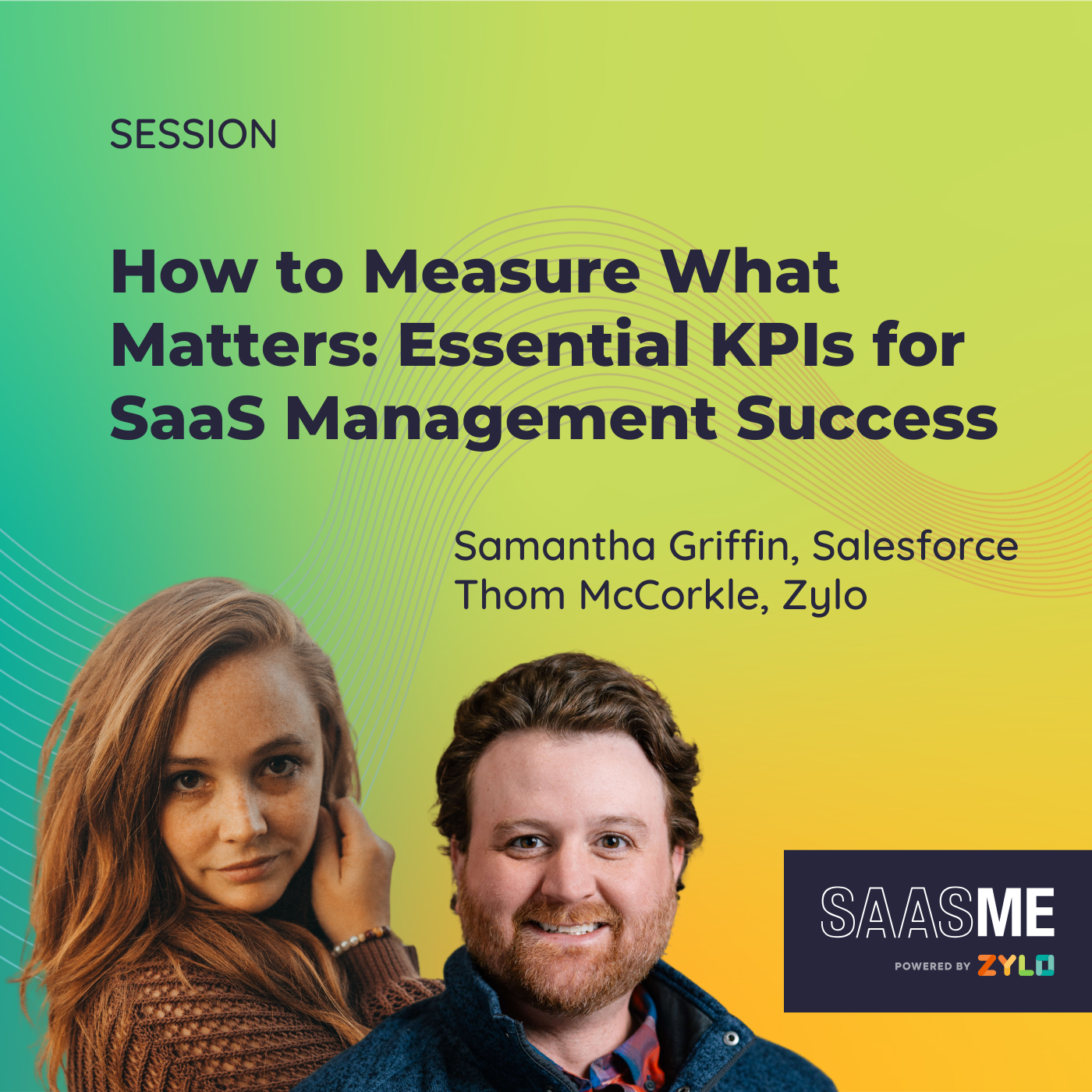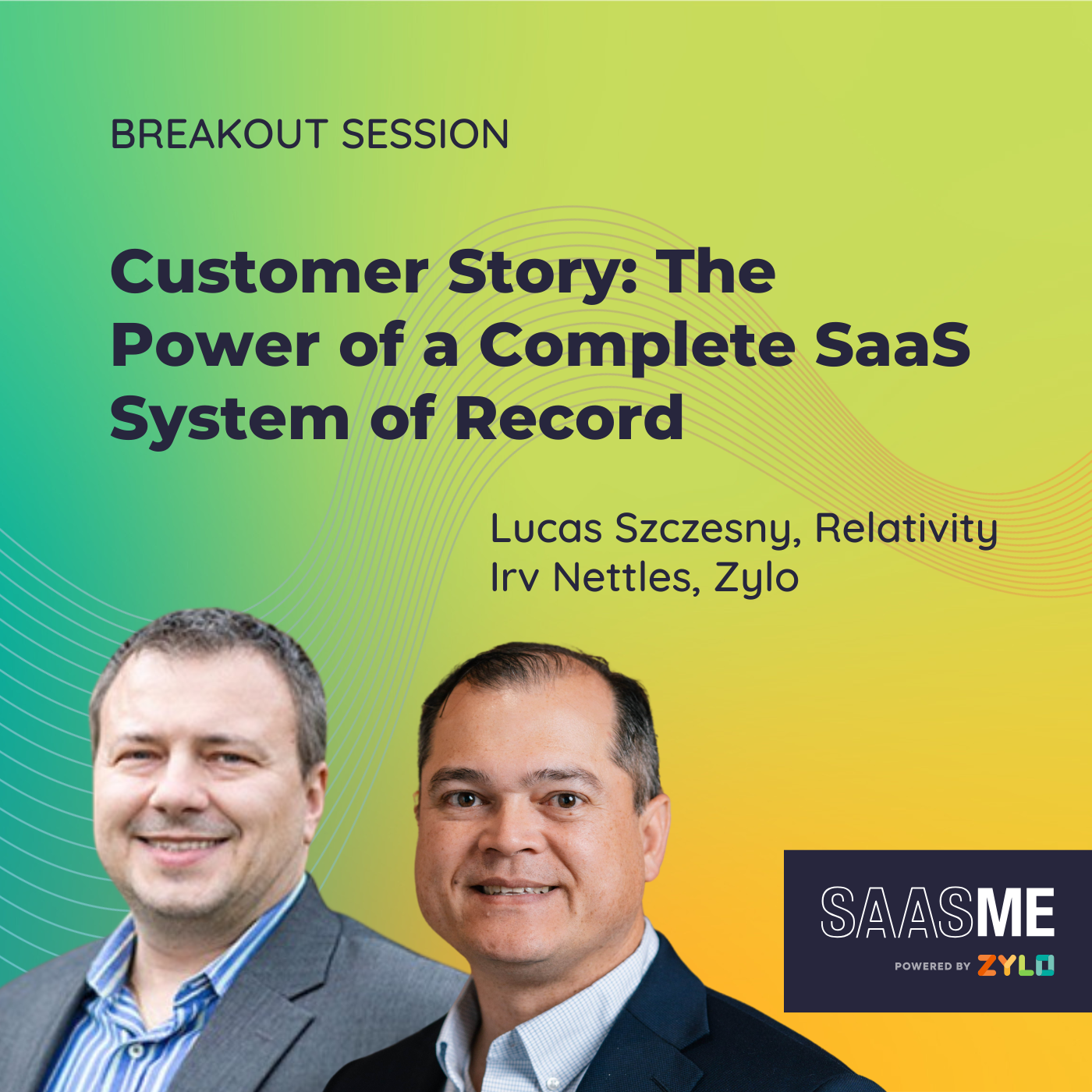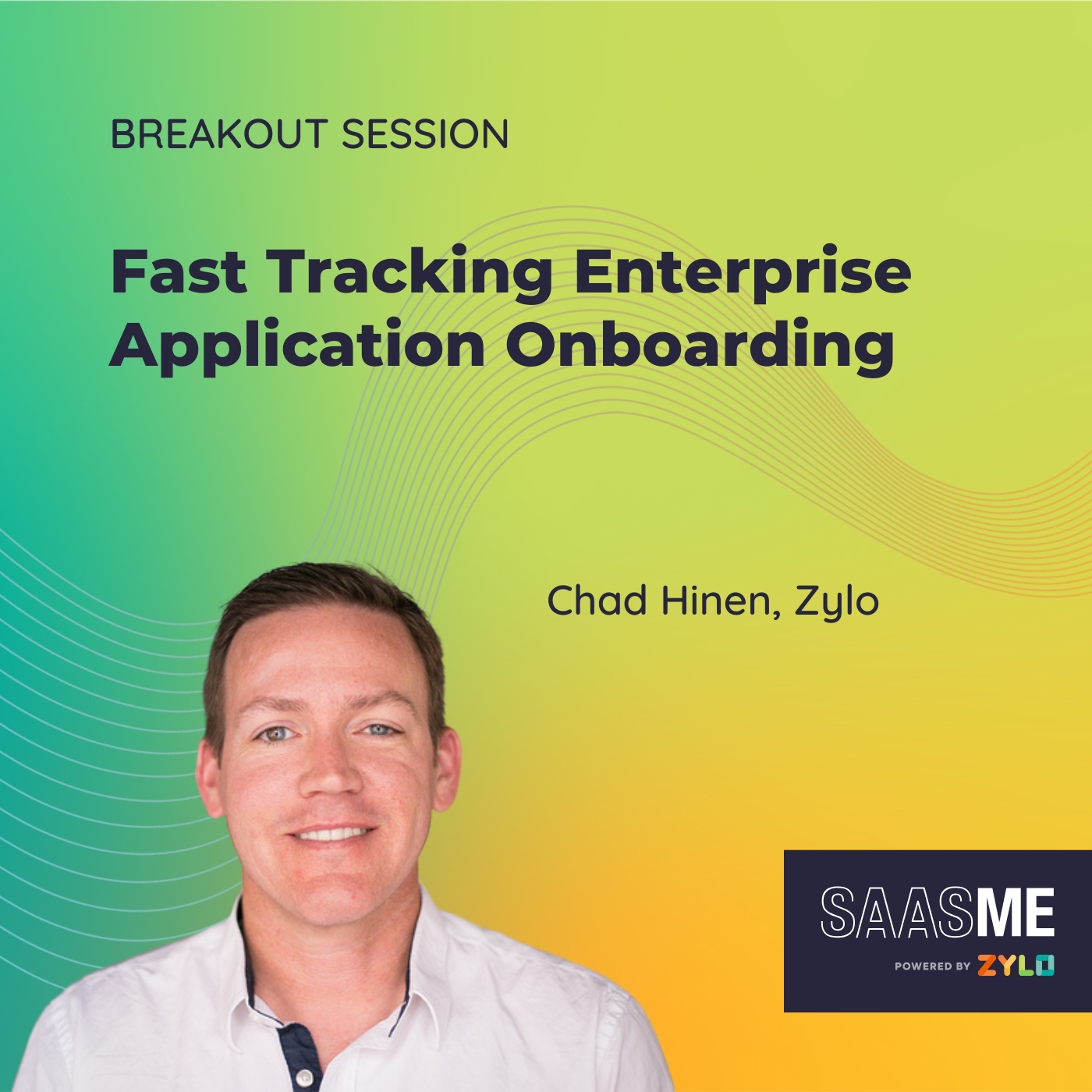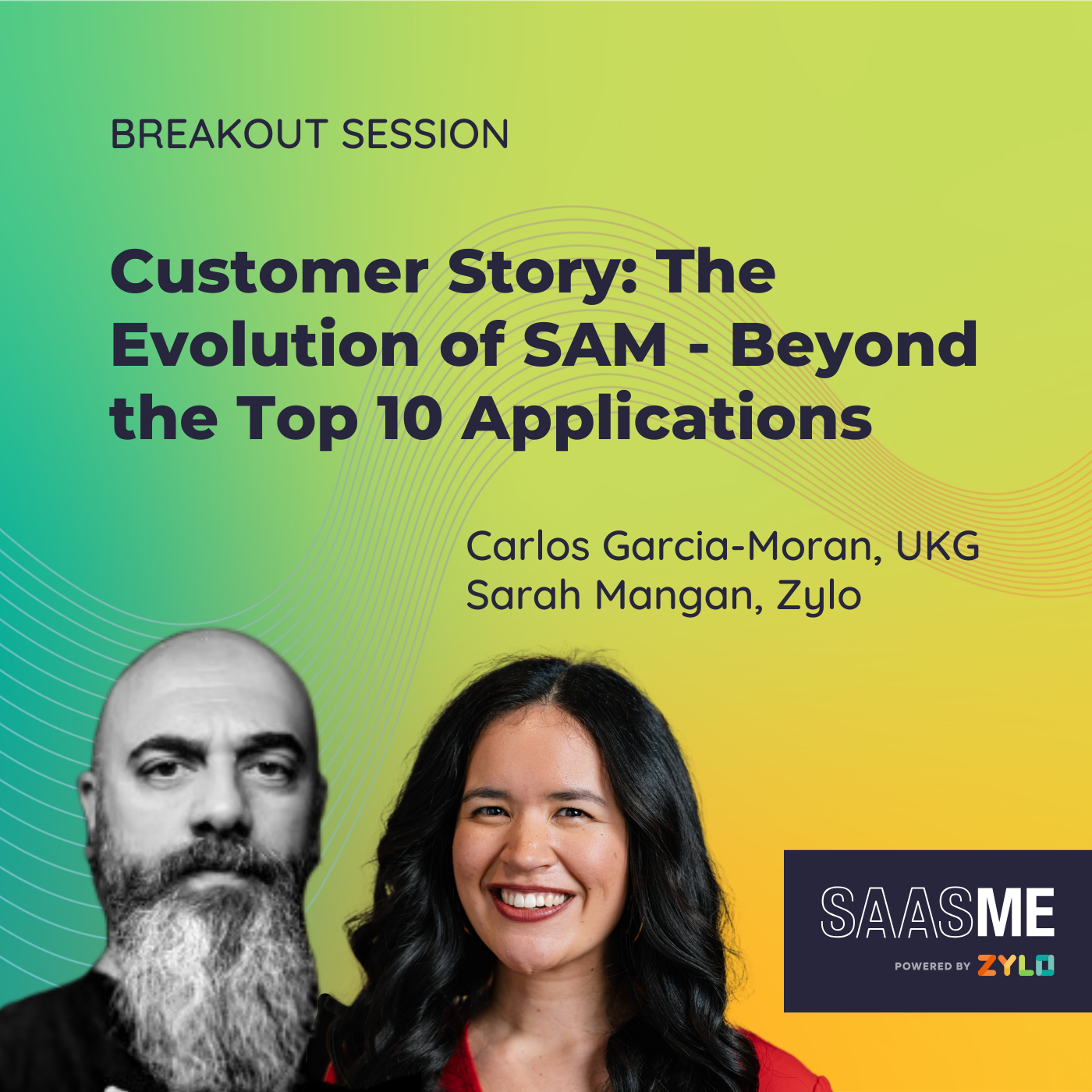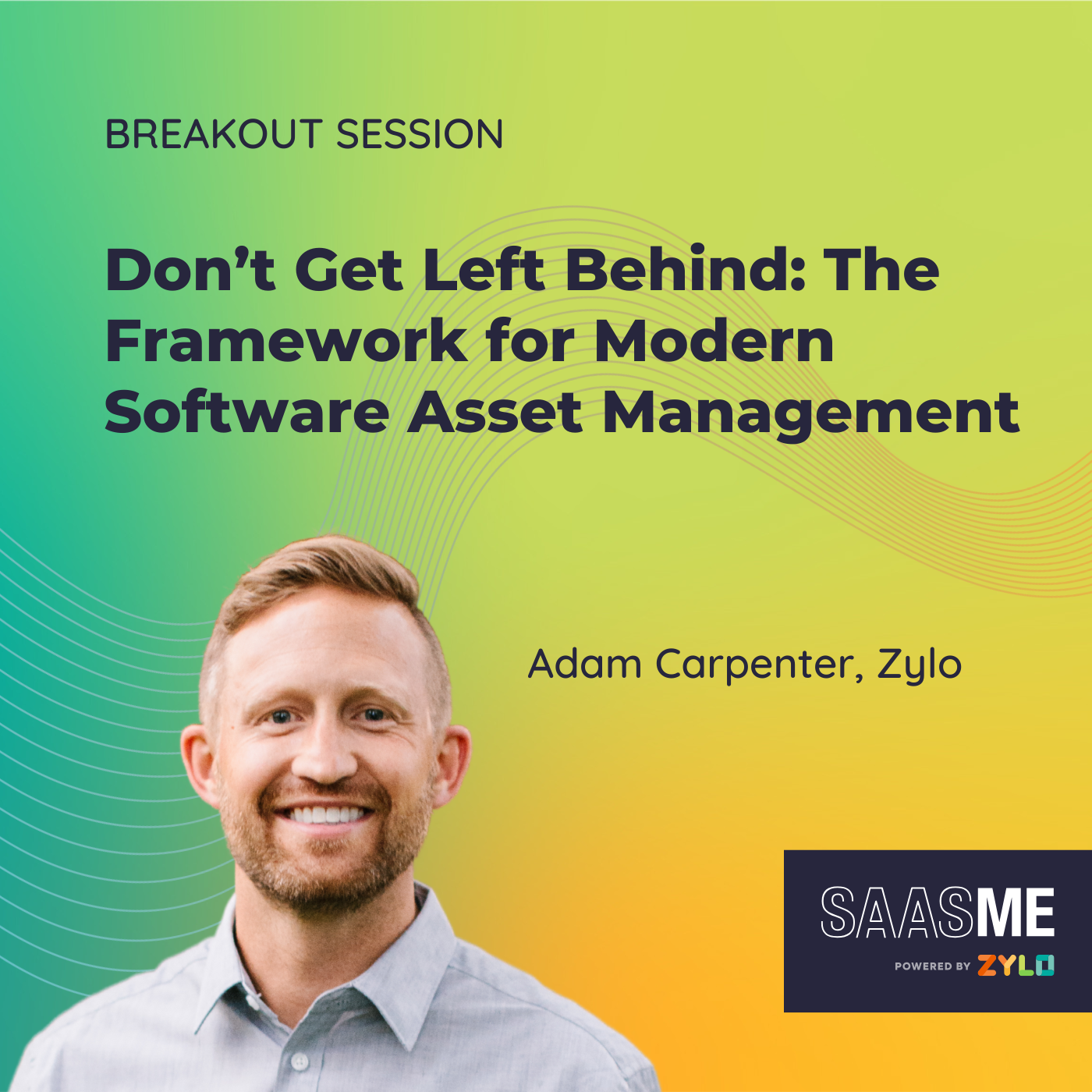Simplifying License Complexity in the Age of AI and Consumption Pricing
- 0.5
- 1
- 1.25
- 1.5
- 1.75
- 2
Ben Pippenger: Hello and thank you all for attending SaaSMe 2025. I am absolutely thrilled for our session today, and let me tell you why. We started Zylo back in 2016, and back in 2016 the world was definitely a much different place than it is today, and B2B SaaS is no exception to that. Since then, the job of managing SaaS in the enterprise has not gotten any easier if anything has gotten more complex and more challenging than ever before. My belief is that the primary factor for that is that the ever- changing landscape of SaaS licensing. So I'm excited to spend the next 20 minutes unpacking that, and hopefully leaving you with some action takeaways to simplify some of that complexity.
Ben Pippenger: To start things off, just a quick intro. So my name is Ben. I'm one of the co- founders here at Zylo, and have had the opportunity over the last eight and a half, nine years to work with many, many customers, a lot of partners, and have had a hand in building the Zylo platform. Today I work in our product organization focused on licensing and usage for SaaS applications. As far as the agenda goes for our session today, I'll be covering off on four key points. Number one, we're going to talk about why software licensing is more complex than ever before. Second thing we'll be covering is what is making tracking usage so challenging? Third, we'll review some winning strategies to stay ahead. And four, I'll leave you with some hopeful actionable takeaways. So let's get started.
Ben Pippenger: Why is SaaS licensing more complex than ever? Well, let's take a look first at just sort of the journey we've all been on since we started doing this way back in 2016. You think about how SaaS started, it was all seat- based licensing. We think Salesforce sort of was the pioneer of this charging for an individual user to access the Salesforce platform. In this model, you paid for seats regardless of the usage by those end users. A couple examples up there, Slack, Asana, Google Workspace, all actually have some AI capabilities built into them, but still primarily a seat- based model. Now we're starting to see more and more consumption- based pricing. So consumption being, you're paying for what you're actually using.
Ben Pippenger: The first bullet there is a hybrid models. So, some of the sort of stalwarts that you saw with seat- based licensing have now started to add in consumption- based pricing. So, a couple examples there. OpenAI, obviously not one of the stalwarts, one of the new ones, but they've got both user- based pricing for the enterprise to be able to give people access to ChatGPT, but then also consumption- based pricing for their OpenAI API. Salesforce and Zendesk both now offer consumption- based pricing. Salesforce on the agent force side and Zendesk for closing out tickets. So for when AI agents are closing out tickets as a result of the work that they're doing, there's fees associated to that. And then all the way on the right- hand side are going to be those consumption or usage- based products that are primarily being monetized and sold based off of usage. So you can see a couple examples there, Datadog, Databricks, Snowflake, prime examples of paying for what you're using versus having a seed- based model in place.
Ben Pippenger: So a quick stat here, this is from Gartner. They came out with this stat last year in August, August 2024 in their paper, How to Negotiate Consumption- Based SaaS Pricing Models. And there they're predicting that by 2027, 80% of organizations will be buying some of their SaaS products via consumption- based pricing models. So, 80% of all the organizations out there will have some form of consumption- based pricing, consumption- based contracts that they're working with their SaaS vendors on. Let's continue digging in here and take a look at some of the trends that we're seeing in the market. This particular survey and the results from this come from Stripe. So if you're not familiar with Stripe, they're a payment processor. A lot of SaaS companies will use them on their websites to charge for things that they're selling, the products that they're selling on their websites. They ran a survey last year where they reached out and the results came back with 2000 plus subscription- based business leaders. And the question was around, how many of them are offering usage- based pricing? 2023, that number was 31%, 2024, that number is 53%. So huge growth that we're seeing that these subscription- based business leaders are now offering some form of consumption- based or usage- based pricing. Another stat comes from High Alpha in their 2024 SaaS benchmark report. In this case, they were reaching out to SaaS companies themselves asking them how they monetize AI products. So the strategy of bringing AI into their platforms. 46%, so about half of them said, it'll be sort of baked into their subscription- based fees, so probably more of that seat- based model, but 25% said usage- based and 22% said hybrid. So some form of subscription plus usage base, and seven is some sort of result or output driven. So as a result of some outcome that's being driven towards, charging for those. So we're looking at about half- and- half, 50 50 of the organizations out there are bringing AI into their products and monetizing that via usage or consumption- based pricing. On top of all of this, we're seeing a lot of unpredictable and confusing licensing changes from vendors. So the example of the top from Smartsheet, if you didn't know Smartsheet, if you're not a Smartsheet customer, haven't experienced this yet, you will when you renew within this year, they've changed their licensing model. And any customer that's buying new or renewing this year is on that new licensing model. And it's causing a lot of confusion of where was I before? How does that impact? What am I renewing on now? You can see some couple of other examples down there from one of my favorite websites, Reddit for people asking for feedback and questions on Zoom room licensing, what does that look like, or DocuSign, and all of a sudden seeing envelope and being charged for overages with my envelope. It is just causing a lot of confusion and a lot of sort of unexpected discussions that have to happen as part of buying and renewing your existing SaaS applications that are out there. And then when you look at all of the different pricing models that are out there. So this data comes from High Alpha again in partnership with Growth Unhinged, just a couple of examples of all of the different pricing models and how they vary wildly across the board. So every app has got their own sort of flavor of what they're charging for and based off of whatever you're doing in their system, and AI is sort of accelerating that trend into new ways that I haven't seen before. So a couple of call- outs here, a couple of examples. You see Zapier's on there, they're charging per task automated. You can see Salesforce I mentioned that earlier, is charging based off of conversations powered through Agentforce, Zendesk through the successful autonomous resolutions of cases. And so, lots of different variations on what to expect. And this is where you really start to think about how the heck am I supposed to understand all these and be able to track and measure all these in a scalable way?
Ben Pippenger: So, that brings us to our next point here. If licensing is confusing, tracking that usage is even harder. Being able to get to the data, understand the data is a big, big challenge and I'm sure a lot of you here at SaaSMe today are starting to face. So, the first point here is that every vendor tracks uses differently. So I showed you that on the previous slide, you have all those different vendors. There's just a very, very small example of the different ways that people are charging for SaaS products these days, but it's across the board, a big mixed bag. And then on top of that, the data to be able to track that is scattered across all sorts of different locations. It may be admin panels, maybe some of it's available through an API, maybe some is some sort of standard that you can pull it out through a billing endpoint. But pulling all of that data, trying to interpret it at scale and make sense of it to know what you should be doing, what you should be buying and what you should be renewing is it's a big, big headache and oftentimes manual and time- consuming. Here's some more examples here of what we're seeing out in the market of different vendors and their usage metrics that they're tracking. So a lot of these are going to be familiar. DocuSign, I mentioned them earlier, but they've got envelope. Envelope set is a usage metric and their pricing model, is either per user, so a typical seat- based thing with some envelope limits baked into that or per envelope. Smartsheet is really sort of traditional per paid user seat, but as I mentioned earlier, they changed their pricing model to incorporate and pull out some of the capabilities that you used to get with a free seat that now requires a paid seat. Datadog monitored hosts and logs, and you're paying primarily per host per log volume or per feature. Snowflake, you're being charged based off data storage and compute, and they do it based off of credits. So you're buying a certain number of credits and then burning down through those. Databricks is on compute usage of per DBU, which is a Data Bricks Unit. Oh my gosh, just going through those already I think probably has your head spinning a little bit. Oh, I'm going to make it spin a little bit more just to show you sort of what Datadog SKUs look like. And Datadog SKUs, I love the title of this slide, are their no dog walk in the park. This is just pulling from their catalog website. On their website, you can go through and sort of see all the stuff that they sell, 50 plus different SKUs. And all of them have diverse pricing models across them. So you're being charged, a lot of times per host but maybe it's per host per month, or maybe you're being charged based off of test runs or based off commits or lots of different ways that they're charging for this. Datadog also has a concept of a high watermark pricing scenario, which complicates things even more for what you're being charged for. So, it just makes it confusing even when you get your bill to understand, " Okay, I'm being billed this much, but how am I supposed to really comprehend that and make sense of it?" You layer in all of that, and when licensing is just this complicated... I mean, as you can imagine, the costs and the security elements of things too to make sure that you really understand what's happening and how your data's being treated and managed also increases. So, what happens is that you can end up with unpredictable costs hitting your desk if you get caught in some sort of overage situation that can completely throw off your budget and anything that you forecasted for the year. Measuring ROI is very difficult. If you're not really able to understand what you're going to be charged for or when, how do you tie that back to the actual business value for the reason that you bought the application? It becomes a big challenge. The constantly changing licensing terms that I highlighted earlier just makes it even more confusing. You think you know what's going on, but then all of a sudden you don't, and everything changes. And then the AI licensing models and the complexity of those that they can introduce security and data privacy risks to understand where's my data? Is it being used to train a model, and how does that impact my overall relationship with that particular vendor? So this stat here, 66.5% of IT leaders have experienced unexpected SaaS charges due to consumption based or AI pricing models. That comes from Zylo's 2025 SaaS Management Index. So 66% of you have experienced some form of unexpected sort of budget busting scenario that happens as a result of this consumption based pricing models.
Ben Pippenger: So there is hope here. So I've sort of painted a doom and gloom picture. I think there's a couple of things that I want to sort of talk through on what we're seeing in the market and what's actually happening out there. So, the first is The FinOps Foundation. So if you're not familiar with The FinOps Foundation, you definitely should be. So go and hit their website, check it out. They're part of the Linux Foundation. They're a third party independent organization that's powered based off of their community of over 70, 000 FinOps practitioners. And what the FinOps Foundation did is originally they built out a framework and a process for how enterprises and organizations should manage their cloud, and the cloud being sort of the big cloud platform. So think about AWS, Google Cloud platform, and Microsoft Azure, and others as well. And they've built sort of clear guidelines and frameworks to help organizations do that. Well, the good news is they've now started to build out some additional frameworks around other areas of spend within organizations, specifically IT or product engineering spend. Just in middle of March, they rolled out their update for 2025 to their framework, and they've added a new concept called Scopes. Essentially, Scopes are identified other areas of spend within organizations where you could apply the FinOps framework to it. One of those scopes is SaaS. So they're starting to put together a lot of details on capabilities that can be supported, maturity models that could be supported for those capabilities. So you can see right here we've got SaaS licensing, AI, and data center as a couple examples of scopes that they're working to help better define and bring forward to have more standardized processes and procedures for managing SaaS and SaaS licensing. They also put out a paper called FinOps for SaaS. I would definitely recommend this is a read as well. It paints nicely sort of the challenges that exist out there, including some of the licensing challenges that we've talked about today. And really starts to, again, frame that picture for how companies can put a framework, a standardized framework in place to help power a FinOps practice for software as a service. I think one point on here that I want to make on this slide that I think is a really important one. When you look at, and this is based off of Zylo's data that we report on. When you look at the overall spend that companies are spending on Cloud or Cloud Plus, Cloud Plus being the SaaS applications, typically we see about half of that spend going to the traditional cloud platforms. So the AWS and GCPs and Azures. The other half is going to SaaS, which is spread across typically lots of vendors. So you are looking at hundreds or potentially thousands of vendors, and that's where a lot of this comes into place for the work that you all are trying to do within your organizations today.
Ben Pippenger: The last thing I'll mention here about The FinOps Foundation is they have part of the group that focuses on what they call FOCUS. It's a standard for billing and usage data that a lot of those major cloud platforms have adopted. So, you think about maybe some of the challenges, if I go to Amazon, I will pull out my billing and usage data. The data I get from their APIs is going to look different than the data I get from Microsoft's APIs for Azure. FOCUS is a standard so that I can go and say, " Hey, Google, Microsoft, Amazon, you support FOCUS, I'm going to pull the data down." When I look at that data set and compare it to what I get from another cloud provider is the same. So it's a standardized data set. They are rolling out FOCUS for SaaS about halfway through this year with the next version of their FOCUS Standard. And so, excited to see sort of how that continues to influence the market and potentially drive some standardization of some of the chaos I described earlier. One more quote here, this is from Gardner. This just came out in March of 2025 in the research note Cloud and AI cost by integrating ITAM and FinOps. The strategic prediction they're making here is that through 2028, organizations that integrate ITAM and FinOps practices to managed software as a service and cloud- based AI will reduce their AI expenses by 30%. So, I think we're seeing a lot of those trends start to come together as we're looking towards the future.
Ben Pippenger: All right, so let's pivot here and spend the next few minutes here thinking about strategies to stay ahead. So how do you start to get your arms around this? How do you take sort of a lot of these learnings that we're sharing today and put them in practice in your own company? A couple key points here. So we'll start on the left- hand side, we'll walk through each step of this slide. So number one is to prioritize your applications. You have hundreds or if not thousands of apps that are used across your company. Really focus in on the apps that have the highest spend maybe, maybe those that are most critical to your business operating, or what I like to call within your sphere of control. So maybe within your own IT world or whatever part of the organization that you're in. Focus on those applications first to be able to get those on, manage them and start to drive whatever it is that you're trying to achieve through the outcomes within your SaaS management program. Second, as I always say, SaaS management is the team sport, it truly is. SaaS touches lots of different parts of the organization, so you need to make sure you're lining across the different teams within your company. So, establish and make sure you're communicating a common strategy across teams like your software asset management, your IT asset management team, your IT team, your FinOps team, as well as your core SaaS management team as well. Third, you need to start by building a strong SaaS management foundation. I mean, honestly, governance is key to a lot of this. You come in, if you want to deploy a process to manage all of these different SaaS apps. You got to make sure you have the governance in place to control what's coming in, make sure it's being monitored, reviewed, approved as you're adding new apps into your environment. Having standards and compliance in place for who gets access and how long they have access for that tool for, and if they're not using it, what happens. And then also processes to off- board applications as well. So you need those strong SaaS management foundation to be successful here.
Ben Pippenger: Fourth area here is to ensure your data is clear and understandable. Data and getting data can be a challenge with SaaS because of all the disparate systems you have to pull it from. Make sure as you're bringing that data in, you understand it. It's inspectable, you know where it came from, you know when it was last updated, and you know what sort of decisions you can make off of it. Fifth column here is to monitor consumption trends. So consumption, if you're not feeling the pain yet or seeing this as part of your responsibility, you will. Make sure you're looking at consumption over time. Putting in place forecasting models in order to anticipate overages and make sure you're staying on top of those in a proactive fashion. Which leads me to my last bullet here is proactive alerting. The last thing you want is to either enter into a true up and realize that you're way over provisioned or get an invoice on your desk where you've been charged a bunch of overage fees as a result of overusing a particular service that you weren't even aware of. So, ensure that you've got proactive alert setups so that you know when those conditions are existing ahead of time, you can take an action maybe to scale back or to go renegotiate with your vendors so that you're in a much better position and not caught on your heels. All right, we'll wrap things up here with a couple key takeaways as you walk away from our session today, and hopefully use some of this in your daily lives. Number one, visibility is key. Visibility is what starts a successful SaaS management program. You really need to know what you have. You need to know who's using it, who the owners are, and what that application costs you. So you've got to go through discovery in order to get to that point.
Ben Pippenger: Next key takeaway is that consumption- based models require new tracking and forecasting strategies. You have to really be thinking about what is being used, how is it being used over time? How do I correctly and accurately forecast what the future looks like? How do I dig into the details to understand what anomalies exist? It's really important to start to think about this is a different type of model, and make sure that you're aligned to the key value that model's going to provide for you.
Ben Pippenger: Fourth, proactive governance and automation can reduce risks and costs. So getting out there, putting in place the foundational components of a SaaS management program, ensuring you have those proactive alerting in place so you're out ahead of things before they happen. And then lastly, consider what the consolidation of FinOps and SaaS management would look like. This is definitely a trend we're seeing in the market. We're seeing more and more FinOps folks, I'm sure there's a lot of you at the conference today. Really, if you haven't gone down that path yet, start to think about what the FinOps framework with the FinOps capabilities look like, and how you can incorporate those in a more standard way into your SaaS management program. All right, that is it for me. I really, really appreciate your time. Really, really appreciate you attending SaaSMe. Feel free to reach out to me directly if you have any questions or thoughts, we'd love to hear from you, and I really hope you enjoy the rest of your day. Thanks.
DESCRIPTION
The future of SaaS licensing is here. With the rise of usage-based pricing models and the surge of AI, managing licenses has never been more complex. Join Zylo co-founder Ben Pippenger as he outlines the challenges ahead and how you can conquer them with confidence. Discover how to simplify the complexity in your stack and build a solid foundation as licensing enters a new era.
Speakers:
- Ben Pippenger, Co-founder & Staff Product Manager at Zylo
Today's Guests




